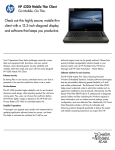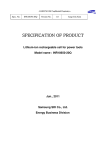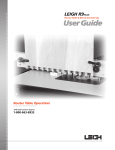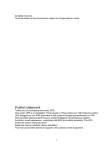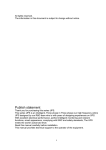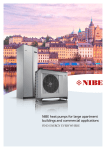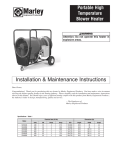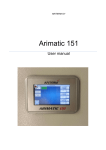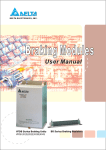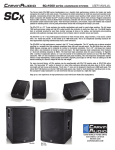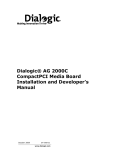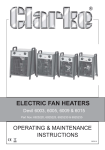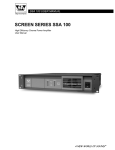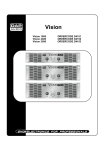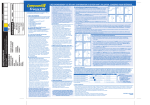Download Hitachi Dynamic Braking Unit Instruction Manual
Transcript
Hitachi America, Ltd. Dynamic Braking Unit HBU-2015/2030/4015/4030/4045/4220 Instruction Manual NOTE: REFER ALSO TO APPLICABLE INVERTER INSTRUCTION MANUAL Manual Number: HAL7201E September 2009 After reading this manual, keep it handy for future reference. Hitachi America, Ltd. Hitachi America, Ltd. Tarrytown, NY Revision History Initial Version – July 2007 Rev A, September 2007 – Added specs, dimensions, terminal configuration, and circuit diagrams for HBU-4220 Rev B, December 2007 – Changed depth dimension on page 11 for 2015/2030/4015/4030/4045/4220 Rev C, February 2008 – Added missing ratings in tables, pages 8-10; improved descriptions on pages 4, 14, 15 and 19; added index Rev D, February 2009 – Added derating curves; AWG wiring sizes; updated web address; clarification of wiring distance and wiring voltage class on page 18 Rev E, September 2009 – Added warning notes about braking activation default jumper position on 400 V class units 2 Hitachi America, Ltd. Tarrytown, NY Safety Precautions Please read through this user’s manual before you use our product. Keep this manual handy for future reference. Definitions used in this manual: CAUTION! – This indicates a potentially hazardous situation that, if not avoided, can result in minor to moderate injury, or serious damage to the product. WARNING! – This indicates a potentially hazardous situation that, if not avoided, can result in serious injury or death. I. General Information The function of the HBU braking unit is to divert into a braking resistor the regenerative energy produced in the process of decelerating the motor, converting that energy into heat. Regenerative energy flows from the motor into the inverter DC Bus, manifested as increased bus voltage. The advantage gained using the HBU is improved braking performance and shorter deceleration time of the load. Before you use the HBU braking unit, please read through this manual and please contact your distributor if you have any questions. This manual will provide you the necessary information for installation, operation, troubleshooting and repair of the HBU braking unit. A. Inspection Please check that the model number is the same as what you ordered BEFORE opening the box. Then, check the contents for any sign of defect or damage during transport. If there is any problem, please contact your Hitachi distributor immediately. B. Braking Unit model numbering convention HBU- □□□□ Braking Unit Code Inverter Input Voltage 2 200 VAC 4 400 VAC (@ 10% ED) Code Inverter Power 015 15 kW 030 30 kW 045 45 kW 220 220 kW 3 Hitachi America, Ltd. Tarrytown, NY C. HBU Series Technical Specifications 200 V SERIES Input and output specifications Power supply Model Peak current (A) * Continuous current (A) Braking Activation Voltage Maximum hysteresis Multiple units DC Bus Voltage Range HBU-2015 HBU-2030 50 90 15 30 380 ±10 VDC (not selectable) ~10 VDC Maximum: 10 HBUs parallel connected 230-380V Power ON The red "power" LED will be on whenever the inverter DC Bus voltage is above ~35VDC Indication functions Ambient temperature The green "braking" LED will be on during braking unit conduction Minus 10˚C to 40˚C (no frost) Ambient humidity 90% RH (no dew) Vibration 10-20hz: 1g, 20-50hz: 0.2g Protection IP20 Weight 2.3 kg/5.1 lbs Braking ON Physical data 400 V SERIES. Model Peak current (A) * Continuous current (A) Input and output Braking Activation Voltage specifications Maximum hysteresis Power supply Indication functions Physical data HBU-4015 HBU-4030 HBU-4045 HBU-4220 25 50 75 250 8 15 25 80 630/660/690/730/760V+-16V (jumper selectable) † About 16V Multiple units Maximum: 10 HBUs parallel connected DC Bus Voltage Range 460-800V Power ON The red "power" LED will be on whenever the inverter DC Bus voltage is above ~35VDC Braking ON The green "braking" LED will be on during braking unit conduction Ambient temperature Minus 10˚C to 40˚C (no frost) Ambient humidity 90% RH (no dew) Vibration 10-20hz: 1g, 20-50hz: 0.2g Protection IP20 Weight 2.3 kg/5.1 lbs 11.6 kg/ 25.5 lbs * Peak current is defined as capacity for 10 seconds maximum, and 10% ED † WARNING: It is critical to set jumper appropriately for the local supply voltage, or damage to the HBU, inverter and or resistors may result. 4 Hitachi America, Ltd. Tarrytown, NY D. Braking Resistor Selection Table for HBU braking unit 200 V SERIES ED = 10%,braking activation voltage = 380 VDC Resistors Quantity of resistors Braking torque (10%ED) % Power of Inverter Model of braking unit Quantity of braking unit 0.4 HBU-2015 1 70W 200Ω 1 220 0.75 HBU-2015 1 70W 200Ω 1 125 1.5 HBU-2015 1 260W 100Ω 1 125 2.2 HBU-2015 1 260W 70Ω 1 120 3.7 HBU-2015 1 390W 40Ω 1 125 5.5 HBU-2015 1 520W 30Ω 1 115 7.5 HBU-2015 1 780W 20Ω 1 125 11 HBU-2015 1 2400W 13.6Ω 1 125 15 HBU-2015 1 3000W 10Ω 1 125 18.5 HBU-2015 2 2400W 16Ω 2 125 22 HBU-2015 2 2400W 13.6Ω 2 125 30 HBU-2015 2 3000W 10Ω 2 125 37 HBU-2015 2 3000W 10Ω 2 100 45 HBU-2015 3 3000W 10Ω 3 120 55 HBU-2030 2 4800W 6.8Ω 2 100 75 HBU-2030 3 4800W 6.8Ω 3 110 90 HBU-2030 4 4800W 6.8Ω 4 120 110 HBU-2030 5 4800W 6.8Ω 5 100 5 Hitachi America, Ltd. Tarrytown, NY 200 V SERIES ED = 20%,braking activation voltage = 380 VDC 6 Resistors Quantity of resistors Braking torque (20%ED) % Power of Inverter Model of braking unit Quantity of braking unit 0.4 HBU-2015 1 140W 200Ω 1 220 0.75 HBU-2015 1 140W 200Ω 1 125 1.5 HBU-2015 1 520W 100Ω 1 125 2.2 HBU-2015 1 520W 70Ω 1 120 3.7 HBU-2015 1 780W 40Ω 1 125 5.5 HBU-2015 1 1KW 30Ω 1 115 7.5 HBU-2015 1 1.5KW 20Ω 1 125 11 HBU-2015 1 4.8KW 13.6Ω 1 125 15 HBU-2015 2 3KW 20Ω 2 125 18.5 HBU-2030 1 9.6KW 8Ω 1 125 22 HBU-2030 1 9.6KW 6.8Ω 1 125 30 HBU-2030 3 4KW 15Ω 3 125 37 HBU-2030 2 6KW 10Ω 2 100 45 HBU-2030 2 9.6KW 6.8Ω 2 120 55 HBU-2030 3 6.4KW 10.2Ω 3 100 75 HBU-2030 4 7.2KW 9Ω 4 110 90 HBU-2030 4 9.6KW 6.8Ω 4 120 110 HBU-2030 5 9.6KW 6.8Ω 5 100 Hitachi America, Ltd. Tarrytown, NY 200 V SERIES ED = 40%,braking activation voltage = 380 VDC Resistors Quantity of resistors Braking torque (40%ED) % Power of Inverter Model of braking unit Quantity of braking unit 0.4 HBU-2015 1 240W 200Ω 1 220 0.75 HBU-2015 1 450W 200Ω 1 125 1.5 HBU-2015 1 900W 100Ω 1 125 2.2 HBU-2015 1 1.3KW 70Ω 1 120 3.7 HBU-2015 1 2.2KW 40Ω 1 125 5.5 HBU-2015 1 3.3KW 30Ω 1 115 7.5 HBU-2015 1 4.5KW 20Ω 1 125 11 HBU-2015 2 3.3KW 27.2Ω 2 125 15 HBU-2030 1 9KW 10Ω 1 125 18.5 HBU-2030 2 6KW 16Ω 2 125 22 HBU-2030 2 6.6KW 13.6Ω 2 125 30 HBU-2030 2 9KW 10Ω 2 125 37 HBU-2030 3 7.5KW 15Ω 3 100 45 HBU-2030 3 9KW 10.2Ω 3 120 55 HBU-2030 4 8.5KW 13.2Ω 4 100 75 HBU-2030 4 12KW 9Ω 4 110 90 HBU-2030 6 9KW 10.2Ω 6 120 110 HBU-2030 8 8.5KW 10.8Ω 8 100 7 Hitachi America, Ltd. Tarrytown, NY 400 V SERIES † ED = 10%,braking activation voltage = 760 VDC Resistors Quantity of resistors Braking torque (10%ED) % Power of Inverter Model of braking unit Quantity of braking unit 0.4 HBU-4015 1 70W 750Ω 1 230 0.75 HBU-4015 1 70W 750Ω 1 130 1.5 HBU-4015 1 260W 400Ω 1 125 2.2 HBU-4015 1 260W 250Ω 1 135 3.7 HBU-4015 1 390W 150Ω 1 135 5.5 HBU-4015 1 520W 100Ω 1 135 7.5 HBU-4015 1 780W 75Ω 1 130 11 HBU-4015 1 1040W 50Ω 1 135 15 HBU-4015 1 1560W 40Ω 1 125 18.5 HBU-4030 1 4800W 32Ω 1 125 22 HBU-4030 1 4800W 27.2Ω 1 125 30 HBU-4030 1 6000W 20Ω 1 125 37 HBU-4045 1 9600W 16Ω 1 125 45 HBU-4045 1 9600W 13.6Ω 1 125 55 HBU-4045 2 6000W 20Ω 2 135 75 HBU-4045 2 9600W 13.6Ω 2 145 90 HBU-4045 2 9600W 13.6 Ω 2 100 110 HBU-4045 3 9600W 13.6Ω 3 100 132 HBU-4220 1 16KW 3.6Ω 1 120 160 HBU-4220 1 40KW 3Ω 1 140 220 HBU-4220 1 60KW 2.5Ω 1 110 300 HBU-4220 2 40KW 3Ω 2 110 600 HBU-4220 4 40KW 3Ω 4 110 † WARNING: It is critical to set the jumper appropriately for the local supply voltage, or damage to the HBU, inverter and or resistors may result. Factory default setting may not be appropriate for your installation! . 8 Hitachi America, Ltd. Tarrytown, NY 400 V SERIES † ED = 20%,braking activation voltage = 760 VDC Resistors Quantity of resistors Braking torque (20%ED) % Power of Inverter Model of braking unit Quantity of braking unit 0.4 HBU-4015 1 140W 750Ω 1 230 0.75 HBU-4015 1 140W 750Ω 1 130 1.5 HBU-4015 1 520W 400Ω 1 125 2.2 HBU-4015 1 520W 250Ω 1 135 3.7 HBU-4015 1 780W 150Ω 1 135 5.5 HBU-4015 1 1040W 100Ω 1 135 7.5 HBU-4015 1 1560W 75Ω 1 130 11 HBU-4015 1 2KW 50Ω 1 135 15 HBU-4030 1 3KW 40Ω 1 125 18.5 HBU-4030 1 9600W 32Ω 1 125 22 HBU-4030 1 9600W 27.2Ω 1 125 30 HBU-4045 1 12KW 20Ω 1 125 37 HBU-4045 1 20KW 16Ω 1 125 45 HBU-4030 2 10KW 27.2Ω 2 125 55 HBU-4045 2 12KW 20Ω 2 135 75 HBU-4045 3 18KW 20.4Ω 3 145 90 HBU-4045 4 12KW 21.2Ω 4 120 110 HBU-4045 4 15KW 18Ω 4 100 132 HBU-4220 1 48KW 3.6Ω 1 120 160 HBU-4220 1 80KW 3Ω 1 140 220 HBU-4220 2 60KW 5Ω 2 110 300 HBU-4220 2 80KW 3Ω 2 110 600 HBU-4220 4 80KW 3Ω 4 110 † WARNING: It is critical to set the jumper appropriately for the local supply voltage, or damage to the HBU, inverter and or resistors may result. Factory default setting may not be appropriate for your installation! . 9 Hitachi America, Ltd. Tarrytown, NY 400 V SERIES † ED = 40%,braking activation voltage = 760 VDC Resistors Quantity of resistors Braking torque (40%ED) % Power of Inverter Model of braking unit Quantity of braking unit 0.4 HBU-4015 1 240W 750Ω 1 230 0.75 HBU-4015 1 450W 750Ω 1 130 1.5 HBU-4015 1 800W 400Ω 1 125 2.2 HBU-4015 1 1.32KW 250Ω 1 135 3.7 HBU-4015 1 2.2KW 150Ω 1 135 5.5 HBU-4015 1 3.3KW 100Ω 1 135 7.5 HBU-4015 1 4.5KW 75Ω 1 130 11 HBU-4030 1 6.6KW 50Ω 1 135 15 HBU-4030 1 9KW 40Ω 1 125 18.5 HBU-4045 1 11KW 32Ω 1 125 22 HBU-4045 1 13.2KW 27.2Ω 1 125 30 HBU-4030 2 10KW 40Ω 2 125 37 HBU-4045 2 11KW 32Ω 2 125 45 HBU-4045 2 13.5KW 27.2Ω 2 125 55 HBU-4045 3 12KW 30Ω 3 135 75 HBU-4045 4 11KW 27.2Ω 4 145 90 HBU-4220 1 54KW 5.3Ω 1 120 110 HBU-4220 1 66KW 4.4Ω 1 100 132 HBU-4220 2 40KW 10Ω 2 130 160 HBU-4220 2 48KW 6Ω 2 140 220 HBU-4220 2 66KW 5Ω 2 110 300 HBU-4220 3 60KW 4.5Ω 3 110 600 HBU-4220 6 60KW 4.5Ω 6 110 † WARNING: It is critical to set the jumper appropriately for the local supply voltage, or damage to the HBU, inverter and or resistors may result. Factory default setting may not be appropriate for your installation! . 10 Hitachi America, Ltd. Tarrytown, NY II. Mounting A. External dimensions of HBU-2015/2030/4015/4030/4045/4220 158 2015/2030/4015/4030/4045 4220 Figure 1 Model Mounting Hole Size (mm) Terminal Screw Size Wire Size (mm2) Wire Size (AWG) 2015/2030/4015/4030/4045 6 M4 4–6 10 – 8 4220 8 M8 16 – 36 4–2 11 Hitachi America, Ltd. Tarrytown, NY B. Braking Unit Front Panel 1. Front Cover Removal Grasp the two sides of the front panel firmly. Remove the two attachment screws at the bottom of the cover by turning counterclockwise. Remove the cover by lifting it upward from the bottom. (Figure 2 A) 2. Front Cover Re-attachment Insert the top tongue of the front cover under the coping. Push the front cover down until it is fully seated. Reinstall the attachment screws at the bottom of the front cover. (3-5N.M) (Figure 2B) e A B Figure 2 - Front cover removal and reinstallation of HBU braking unit. C. Cautions for Installation CAUTION! 1. Please install the braking unit on a non-flammable wall or panel. Otherwise there is risk of fire. 2. If you install braking units in an enclosure, be sure to size the panel properly and provide adequate cooling/ventilation as necessary to ensure the internal temperature remains lower than +40˚C. 3. It is normal for this braking unit to become hot during operation. Therefore be sure nothing flammable or explosive comes in contact with it while it is in use. Otherwise there is risk of fire. 1. Installation considerations: o If installed in a cabinet, the cabinet should be adequately ventilated. o Ambient temperature should be between -10˚C and +40˚C, or if NOT in a cabinet, between -10˚C and +50˚C (no frost) o Humidity < 90% RH, non-condensing. o Do not install the braking unit on wooden board or any flammable surface. o Do not install where the unit will be exposed to direct sunlight. o Do not install near flammable, explosive or caustic gases or liquids o Protect from dust and strong electromagnetic fields. 12 Hitachi America, Ltd. Tarrytown, NY 2. Ambient temperature: In order to improve the life and reliability of the braking unit, please install it in a well-ventilated area. If you install braking units in an enclosure, be sure to size the panel properly and provide adequate cooling/ventilation as necessary to ensure the internal temperature remains lower than +40˚C. 3. Other precautions for installation: Before installation, cover the ventilation grills on the braking unit with tape to keep out dust and metal fragments. After installation is completed, be sure to remove any tape or other coverings from the ventilation grills. 4. Mounting clearance: Provide adequate top, bottom and side clearance around the HBU according to the following diagram: >10 cm >5 cm HBU >5 cm Figure 3 >10 cm 13 Hitachi America, Ltd. Tarrytown, NY III. Installation and Operation WARNING! 1. The inverter DC Bus can hold a dangerous electrical charge for some time after AC power had been removed. Make sure that the inverter input power has been turned off for at least 10 minutes before you attempt to make any wiring connections to the HBU.. 2. Wiring should be done by a licensed electrician following applicable codes and generally accepted wiring practices. 3. Do not touch the terminals or internal components of the braking unit while the DC bus is charged. 4. Make sure that no wire strands contact the metal case of the HBU, or cause a short circuit between the terminals. CAUTION! 1. Be sure to connect the braking resistors, braking unit and inverter according to the connection diagram. 2. Tighten the terminal screws according the specified torque. A. General instructions 1. Use wire gauge > 4 mm2 on power supply connection and resistor connection. 2. Check that the connections are correct before you connect to the power supply. Refer to the wiring diagram in Figure 4 for the necessary connections for P and N, and recommended use of fault alarm functions. The terminal arrangement is shown in Figure 7. 3. The HBU incorporates internal fault detection which can be monitored externally through the relay alarm output terminals marked Tb and Tc. Should the HBU detect an internal fault, the relay will energize and the state of the Tb/Tc output will change. These terminals should be wired to a safety circuit as appropriate. In the factory default configuration, the Tb/Tc output will CLOSE when the HBU detects a high internal temperature, and will be OPEN otherwise. An HBU fault will cause an external trip fault in the inverter. Note: Jumper J8 will change the logic sense of the Tb/Tc output from NO to NC (Figure 5) should your system so require. However, it is recommended to use the factory default setting as described. Refer to the Inverter Instruction Manual for more specific details about how to wire and set up an external trip input. 4. The resistor(s) must incorporate an internal thermal switch (usually open-on-fault type), and this must be wired with a safety circuit that will remove power to the inverter. A typical configuration is shown in Figure 4. In this way, a resistor over-temperature condition, or a break in the alarm wiring, will cause power to be removed from the inverter. 5. IMPORTANT NOTE: On 400 V models only, there are five voltage settings (630V, 660V, 690V, 730V, and 760V) for unit activation. The braking voltage MUST be set to meet the needs of the application. Set the voltage by moving the jumper on inside the HBU to the pair of pins that correspond to the activation voltage desired. Note: 14 Hitachi America, Ltd. Tarrytown, NY On 200 V models, the activation voltage is fixed at 380 VDC. 6. When using multiple HBU units, please refer to section III, B on page 16. The first braking unit should have its jumper set to the MASTER position, and braking units number 2 through N should have their jumpers in the SLAVE position. 7. Ensure that the case of braking unit is well grounded. 8. All units except the HBU-4220 are completely powered from the DC bus (P and N terminals) of the inverter. The HBU-4220 also requires single phase AC power to operate. The HBU-4220 also includes terminals marked R and S, which must be connected to the corresponding terminals on the AC input side of the inverter, as shown below. HBU-4220 Only R S Fault relay energizes when HBU internal temperature is too high REQUIRED FOR SAFETY Figure 4 Typical Alarm and Safety Circuit WARNING! Be sure to utilize a power disconnection method as shown in Figure 4 above, which removes power from the inverter should the braking resistor overheat. Failure to do so may result in risk of fire, injury or death. WARNING! On 400 V class, be certain to verify the correct jumper position for braking activation level BEFORE applying power to the system. Otherwise there is risk of damage to the HBU, the inverter, and/or the resistor(s). 15 Hitachi America, Ltd. Tarrytown, NY Jumper block Factory Default Position for Normally Open (N.O.) Operation (recommended) Position for Normally Closed (N.C.) Operation (not recommended) Jumper J8 Setting Figure 5 16 Hitachi America, Ltd. Tarrytown, NY B. Connecting Multiple HBU Units Connection Diagram for HBU-2015/2030/4015/4030/4045 Resistor N P MASTER INVERTER * SLAVE MASTER MASTER * SLAVE * SLAVE * IMPORTANT! Move jumper to appropriate position for your installation. All units should be configured to the same voltage. Figure 6 17 Hitachi America, Ltd. Tarrytown, NY Ta Tc Tb IN+ IN- OUT+ OUT-Ta Tb Tc IN+ IN- OUT+ OUT- Tb N R S N P P1 HBU-4220 4220 PB P P1 Tc PB HBU-2015/2030/4015/4030/4045 2015/2030/4030/4045 Figure 7 C. Simplified circuit diagram of the braking unit D. Wiring 1. The wiring to the HBU should be passed through the wiring hole provided on the bottom of the unit. 2. The wires from the HBU to the inverter and to the resistor carry high current with significant harmonic content. To minimize the chance for interference, lay out signal wire as far away as possible from these high current wires. Use shielded signal wires as necessary to eliminate interference. 3. The wiring distance between braking unit and braking resistor and between braking unit and inverter should meet the requirements as followed pictures. Please do make sure that the connections between those units are in a bundle and they should be shielded or twisted pair. 4. For 400 V class units, 1000 V rated wire should be used. For 200 V class, 600 V rated wire is sufficient. Braking Resistor 18 10 meters maximum Braking Unit 5 meters maximum Inverter Hitachi America, Ltd. Tarrytown, NY E. Operation 1. Recheck all wiring and connections before applying power to the inverter. 2. Operation of the HBU is automatic once installed. It will turn on when the voltage of the inverter DC Bus exceeds the activation voltage setting. When activated, the HBU draws current off the DC Bus and passes it to the braking resistor(s). In so doing, it will dissipate the regenerative energy from the motor load as heat. 3. Do not touch the braking resistor while the inverter is operating. The resistor may become very hot during normal operation. 4. Inside the HBU front metal cover, on the internal printed circuit board, there are two LED indicators. The red LED – “POWER” – will be ON when the voltage between the DC Bus P and N of inverter is higher than 35V; and the green LED – “BRAKING” – will be ON when the DC bus level is above the activation voltage and the braking unit is therefore passing current to the resistor(s). WARNING! Do not disassemble the HBU when it is connected to an inverter and the power is applied! CAUTION! Do not touch the braking resistor while the inverter is energized. Its surface may be very hot during normal operation, and there is risk of injury. 19 Hitachi America, Ltd. Tarrytown, NY IV. Troubleshooting The internal protection circuit of the braking unit will cause it to shut down in the case of any internal malfunction. Should this occur, it would likely result in an over voltage trip on the inverter. In case of difficulty, use the table below to try to find possible solutions. Should this not resolve the problem, please contact your Hitachi distributor for further assistance. Item Symptom Possible Cause Solution Wiring error Check the wiring 1 The “POWER” light of the braking unit is not illuminated when the inverter is energized HBU set for “SLAVE” Confirm that the jumper is set for “MASTER” Short circuit on Braking unit IGBT Change the braking unit Wrong connection of the braking resistor. Examine the braking resistance and its connection. AC Input to the inverter is high Check that AC supply is within spec Wiring error Recheck connections The capacity of braking unit and braking resistor is not enough. Examine the design and recalculate it. Braking usage rate (%ED) is too high Examine the design and recalculate it. 2 3 4 20 The “BRAKING” light is on all the time. “Over voltage” trip on inverter. The braking unit trips because the temperature of resistor is too high. Reduce the ambient The ambient temperature is temperature where the HBU over 40˚C is installed. Hitachi America, Ltd. Tarrytown, NY 21 Hitachi America, Ltd. Tarrytown, NY 22 Hitachi America, Ltd. Tarrytown, NY INDEX A M Alarm relay · 14 Model numbering · 3 Ambient temperature · 13 Mounting · 11 Mounting Clearance · 13 C Cover installation · 12 Cover removal · 12 Multiple unit connection · 17 O Operation · 19 D Derating Curves · 21, 22 Dimensions · 11 P Power requirements · 15 Distance, wiring · 18 R F Resistor Selection · 5, 6, 7, 8, 9, 10 Fault detection · 14 Revision History · 2 G S Grounding · 15 Safety Circuit · 15 Safety Precautions · 3 I Internal circuit · 18 J Jumper, activation voltage · 4, 8, 9, 10, 15 Specifications · 4 T Terminal arrangement · 18 Themal protection, resistor · 14 Troubleshooting · 20 Jumper, alarm contact · 16 W L LED indicators · 19 Wire gauge · 11, 14 Wiring · 18 Wiring schematic · 15 23 Hitachi America, Ltd. Tarrytown, NY Hitachi America, Ltd. 50 Prospect Avenue Tarrytown, NY 10591 For Technical Support, contact your Hitachi Distributor, Or visit: www.hitachi-america.us/inverters © Hitachi America, Ltd. Manual Number: HAL7201E – September 2009 24
























